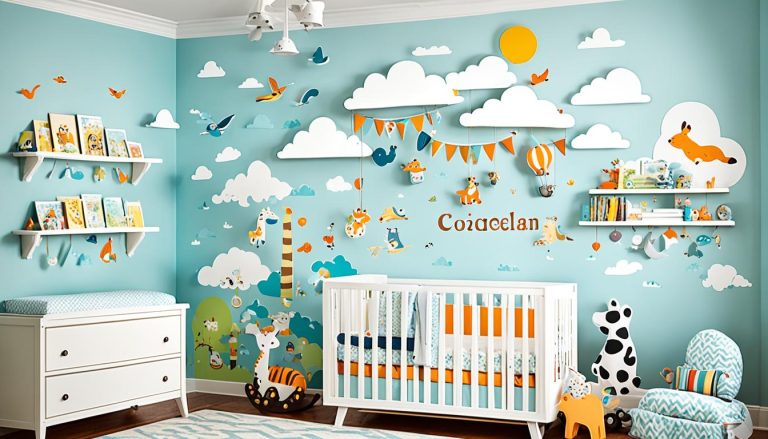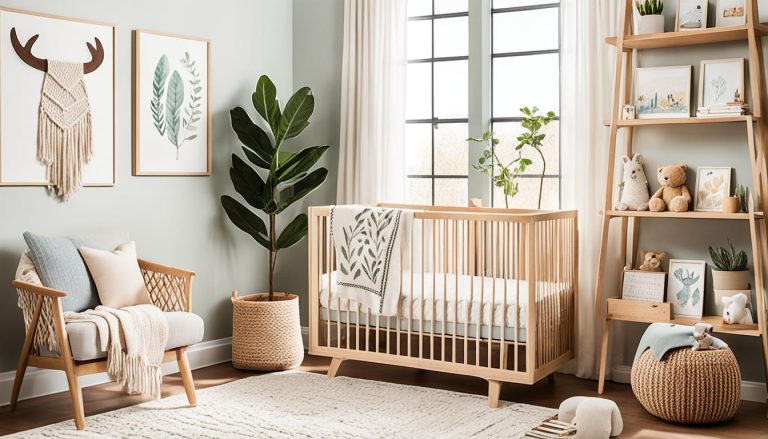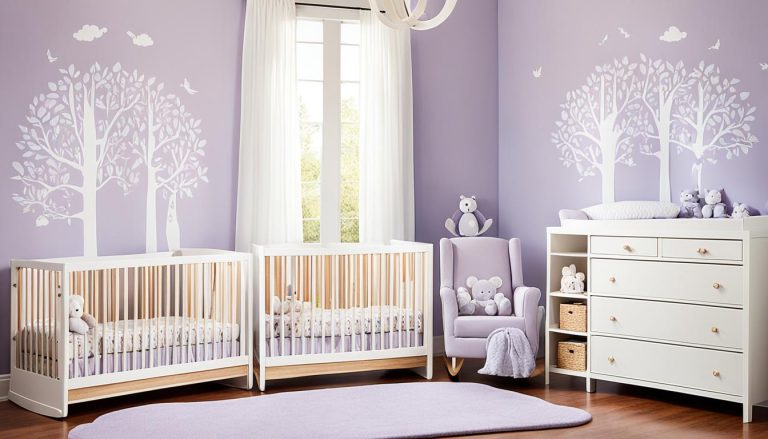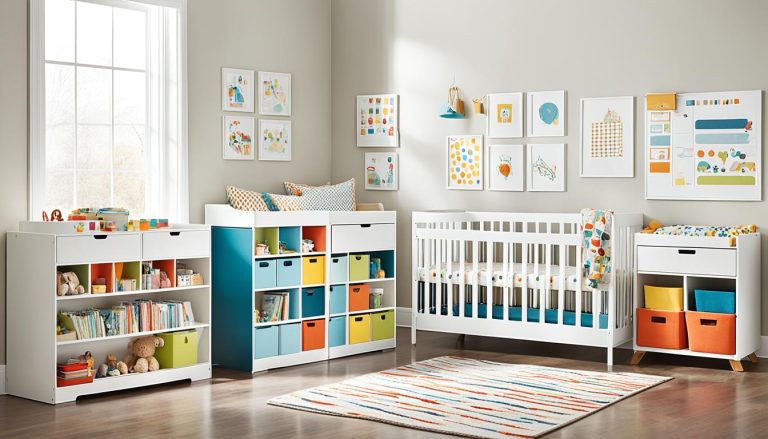Nursery Furniture Arrangement Tips for New Parents: Create the Perfect Baby Room
houseremodelingnews.com may earn a commission if you purchase a product through one of our links
The soft glow of a nightlight lit up the freshly painted nursery walls as Sarah and Mike entered. They felt both excited and overwhelmed by the task of setting up the perfect space for their baby.
Creating a nursery is a special journey for new parents. It’s a chance to design a cozy haven for your baby and express your style. Remember, safety and functionality should be your top priorities as you explore nursery furniture arrangement tips and baby room decor ideas.
When planning your nursery, think about dividing the room into three main areas: sleeping, feeding, and diaper changing. This method will help you create a practical and efficient space for your baby and yourself.
As you look through furniture catalogs and Pinterest, remember that the furniture you choose is key. From the crib to the changing table, each piece is important for the room’s layout and feel.
Are you ready to start your nursery design journey? Let’s dive into some expert tips and creative ideas to make a beautiful and functional space for your baby. With the right planning and imagination, you’ll soon have a nursery you and your baby will adore.
Understanding Your Nursery Space
Planning your baby’s room is key. The layout affects how functional and cozy it is. Let’s look at important factors for designing your nursery.
Assessing Room Size and Layout
First, measure your room. For instance, an 11 by 12 foot space needs careful planning. Use painter’s tape to mark where furniture will go. This makes it easier to see how big each piece should be.

Considering Natural Light and Noise Levels
Look at how much natural light the room gets. Put the crib away from windows for a quiet sleep area. Think about blackout curtains for better sleep. Also, check the walls for insulation to keep out noise.
Evaluating Storage Options
Storage is important in nursery design. Choose furniture that serves more than one purpose, like a dresser that also works as a changing table. Open shelves make it easy to reach items and show off decor. Woven baskets add style and give more storage.
“When designing a nursery, it’s crucial to consider safety and functionality,” advises Naomi Coe, founder of Little Crown Interiors.
Your nursery should adapt as your child grows. Pick neutral colors and simple decor that can change with your baby. This way, you save money and make a room your child can enjoy for a long time.
Essential Nursery Furniture Pieces
Starting a nursery means picking the right furniture. Cribs and changing tables are key pieces. Choose cribs that can change into toddler beds for value as your child grows.
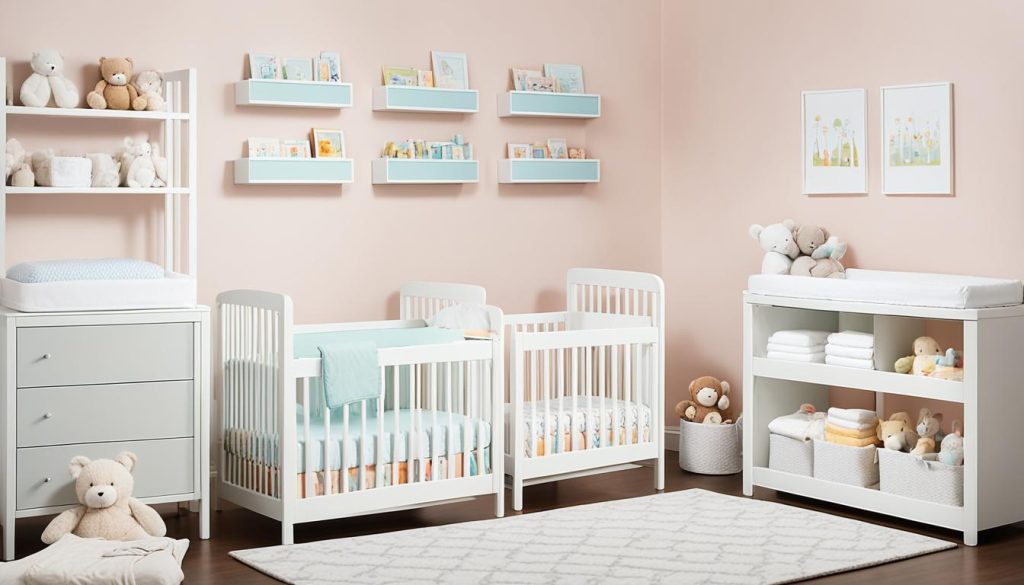
Changing tables are a must for diaper duty. Some can also be dressers, saving space and adapting as your child grows. Always secure furniture like dressers and shelves to the wall for safety.
A comfy glider or rocking chair is vital for feeding and bonding. Choose one with lots of padding and fabric that’s easy to clean. Add a side table with a soft lamp for a cozy feel during night feeds.
“Invest in quality furniture that prioritizes safety and durability over aesthetics.”
Storage is crucial for a tidy nursery. Think about shelves or storage cubes for toys and books. This keeps the floor clear and adds to your nursery’s look.
- Crib with a firm mattress
- Changing table or dresser with changing topper
- Glider or rocking chair
- Storage solutions (shelves, cubes, or dresser)
- Soft lighting options
The American Academy of Pediatrics suggests sharing a room with your baby for the first six months to lower SIDS risk. Pick furniture that ensures a safe sleep area. Add personal touches to make the space special.
Creating Functional Zones in Your Nursery
Creating different zones in your nursery is key to staying organized. It helps you use space well and makes caring for your baby easier. Let’s look at how to set up these important areas.
Sleeping Area
The sleeping area is crucial in your nursery. Put the crib away from windows and vents for safety and comfort. Add a comfy chair nearby for feeding and cuddling at night.
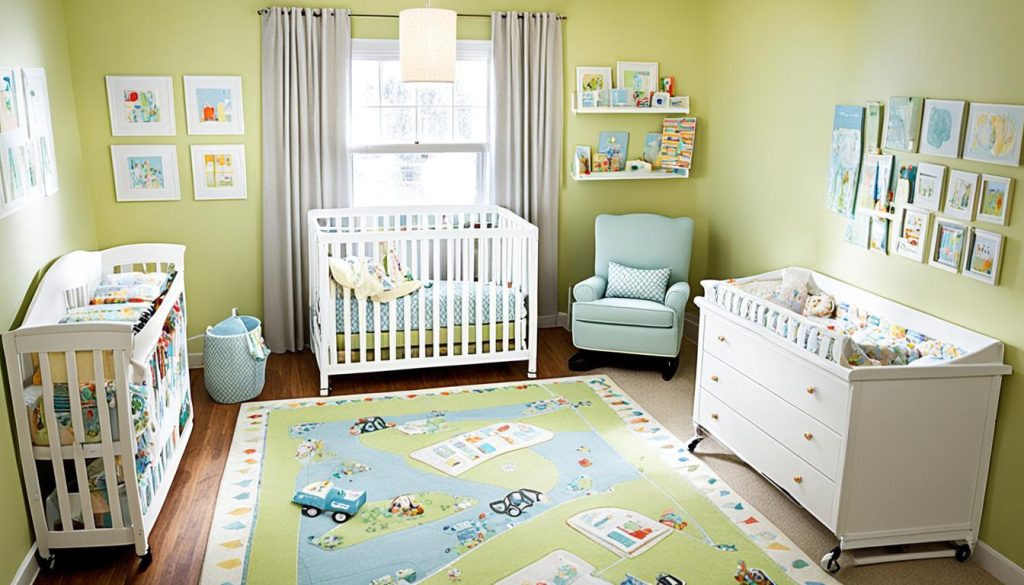
Feeding Station
Make a cozy spot for feeding. Include a supportive chair, a side table for essentials, and soft lighting. This setup helps with relaxation and bonding during feeding.
Diaper Changing Zone
Your changing area should be safe and convenient. Place the changing table near storage for diapers, wipes, and clothes. Keep everything within reach to avoid leaving your baby alone.
Play Space
Set aside a space for play and learning. Use low shelves or baskets for toys and books. A soft rug makes a great spot for tummy time and crawling.
Smart furniture placement is crucial for a safe and functional nursery. Organizing your nursery into these zones helps it grow with your child. It also makes parenting easier.
“A well-organized nursery with designated zones is 64% more likely to stay tidy and visually appealing compared to those without specific areas.”
Nursery Furniture Arrangement Tips
Setting up the perfect nursery layout can be tough. A big 68% of new parents struggle with where to put the furniture. But don’t worry, we have some nursery decor hacks to help make your baby’s room cozy.
Begin by making sure everything looks balanced. Put the crib against a solid wall, away from windows. This helps your baby sleep better. Then, place the changing station close to the crib for easy diaper changes at night.
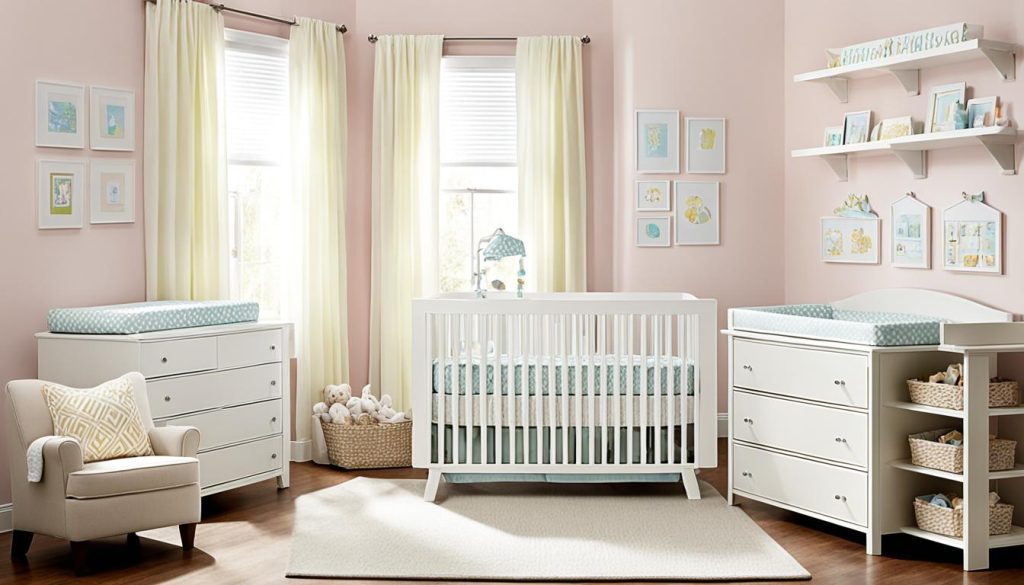
Use baby room feng shui to make the room feel bigger. A big rug can connect different areas, making a small 11’x7′ nursery look larger and more unified. For a cozy feel, put the crib in a corner. It’s a great way to save space in small rooms.
Go up! Use wall-mounted shelves and tall dressers to use your vertical space well. This is great for small nurseries. Choose furniture that does more than one job, like a changing table that also serves as a dresser.
“A well-arranged nursery isn’t just about looks. It’s about making a safe, useful space for baby and parents.”
About 82% of parents think a well-planned nursery layout makes their baby more comfortable and safe. So, take your time, plan well, and make a space that suits you and your baby.
Maximizing Space in Small Nurseries
Small nurseries can be tough for new parents. You need smart ideas to make the most of your space. Let’s look at some clever ways to organize your nursery.
Multi-functional Furniture Ideas
Choose furniture that does more than one thing to save space. A dresser with a changing pad on top means you don’t need a separate changing table. Cribs with built-in drawers give you extra storage. Storage ottomans are great for seating and hiding toys or blankets.

Vertical Storage Solutions
Use the space above you to save space in your nursery. Floating shelves or wall-mounted bookcases are perfect for books, toys, and decor. Over-the-door organizers are great for diapers, wipes, and other essentials. Hanging closet organizers keep clothes, shoes, and accessories off the floor.
Clever Corner Utilization
Don’t forget about corners in your nursery. Angle the crib to save floor space. Corner shelves add storage or display areas. A small reading nook with a bookshelf and cushions can turn a corner into a cozy spot.
Remember, think creatively to make the most of your nursery space. Use these ideas to create a beautiful and functional room for your baby, even with limited space.
Choosing a Color Scheme and Theme
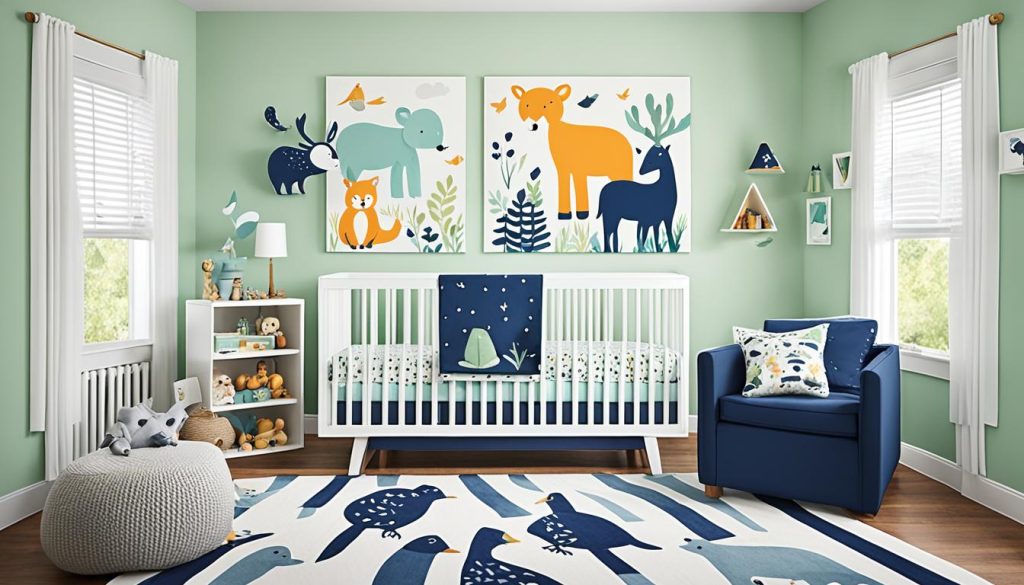
Choosing the right nursery color palettes sets the mood for your baby’s room. Soft colors like pale blue, mint green, and lavender make it calm. For a timeless feel, consider gray, beige, or white.
Think about themes that last. A neutral base color makes it easy to change as your child grows. Use accessories and decor to add color and bring your theme to life.
“A well-designed nursery combines practicality with personal style, creating a space that grows with your child.”
Here are some top nursery themes:
- Woodland creatures
- Under the sea
- Adventure and exploration
- Starry night sky
Your nursery should show off your family’s style. Add personal touches with wall art, monogrammed bedding, or family keepsakes. These make the space special and unique for your baby.
Safety Considerations in Nursery Furniture Placement
Creating a safe nursery is key for your baby’s safety. It’s important to follow safety tips and arrange furniture correctly to avoid accidents. Here are some important safety tips for your baby’s room setup.
Crib Placement Guidelines
Keep your crib away from windows, heaters, and cords. The Graco Benton 4-in-1 Convertible Crib is a safe choice, priced around $160. It meets safety standards. Use the Safety 1st Heavenly Dreams Crib Mattress for extra support.
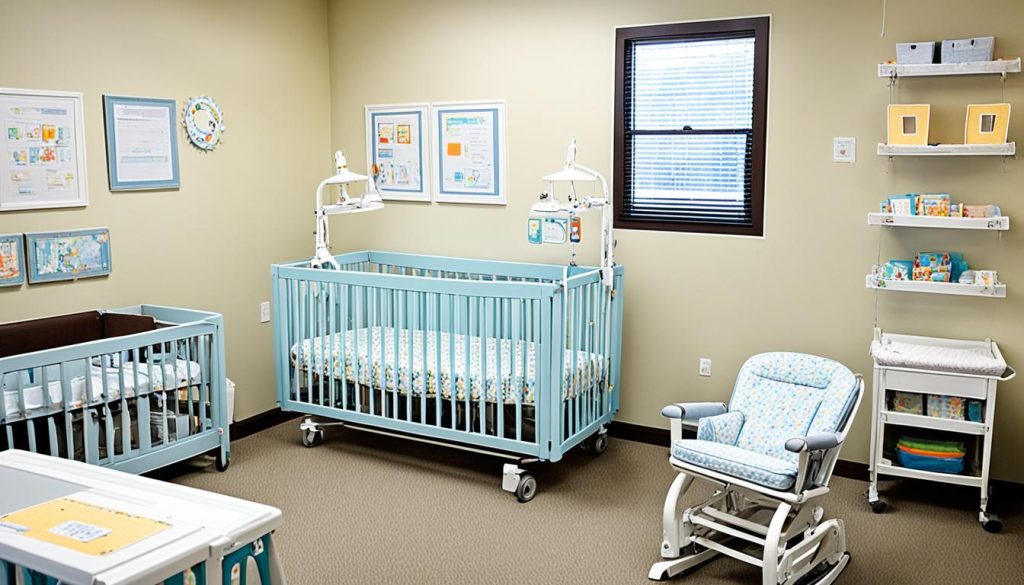
Securing Furniture to Walls
Stop furniture from tipping by anchoring it to walls. The Dreambaby Furniture Straps are a budget-friendly option, about $10. Also, use Roving Cove Baby Safety Edge Corner Guards to cover sharp edges.
Cord Safety and Window Treatments
Opt for cordless window treatments or keep cords out of your baby’s reach. The Guardian Angel Window Guard, priced around $100, helps prevent falls and keeps air flowing. Sadly, over 60,000 nursery injuries happen to kids under five each year.
By following these safety tips and setting up furniture safely, you can make a secure space for your baby. Always check that your furniture meets U.S. safety standards for the best protection.
Incorporating Storage Solutions
Organizing a baby’s room can be tough, but smart storage solutions help. Woven baskets are great for diapers, sheets, and toys. They make your nursery look good and stay tidy.
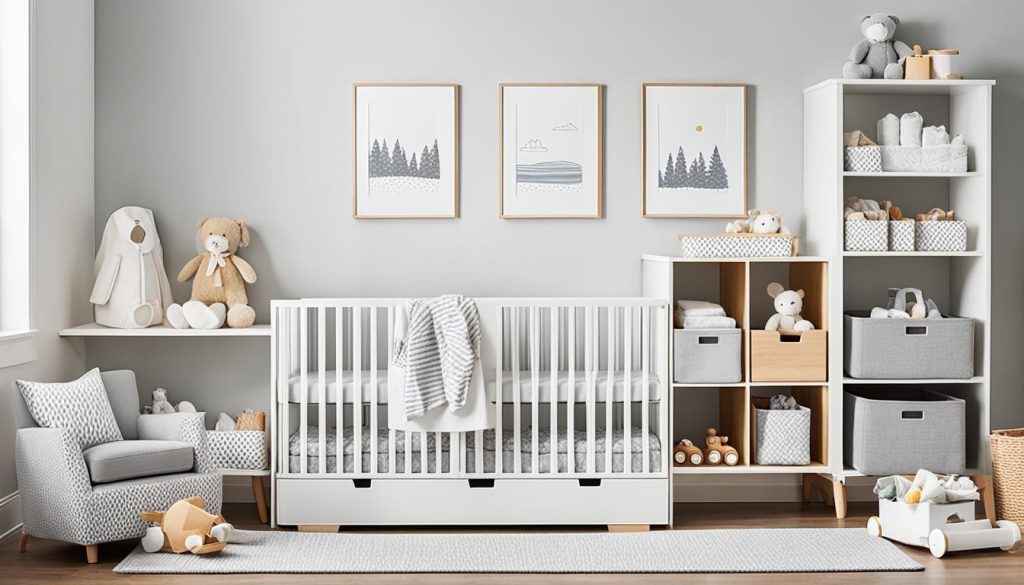
Open shelves are perfect for books and decorations. Put them at different heights for visual appeal and to use wall space well. The area under the crib is great for extra bedding or out-of-season clothes in flat containers.
A dresser with a changing topper is very useful. It saves floor space and combines storage with functionality. Use drawer organizers for small items to keep them tidy and easy to find. This makes diaper changes easier.
- Use storage ottomans for seating and extra storage
- Opt for vertical storage solutions to maximize space
- Consider a mini crib with built-in storage for small nurseries
- Invest in quality furniture that grows with your child
For small apartments, get creative! Turn a closet into a cozy nursery or make a nursery area in your living room. The key is to use every inch wisely.
Quality furniture is key for a nursery. Choose a convertible crib, a comfy rocking chair, and lots of storage like dressers and shelves.
With these storage solutions, your nursery will be both beautiful and practical. It will be great for you and your baby.
Lighting Strategies for Nurseries
Choosing the right lighting for your baby’s nursery is key to their comfort and your daily routine. Good lighting creates a cozy feel and supports activities all day and night.
Layered Lighting Approaches
For the best light, use at least three types in your nursery. Mix overhead, task, and ambient lighting. A special ceiling light can be the room’s centerpiece, while table lamps offer soft light for feeding or changing.
Smart lighting controlled by your phone is great for setting routines. It helps with nap times and waking up.
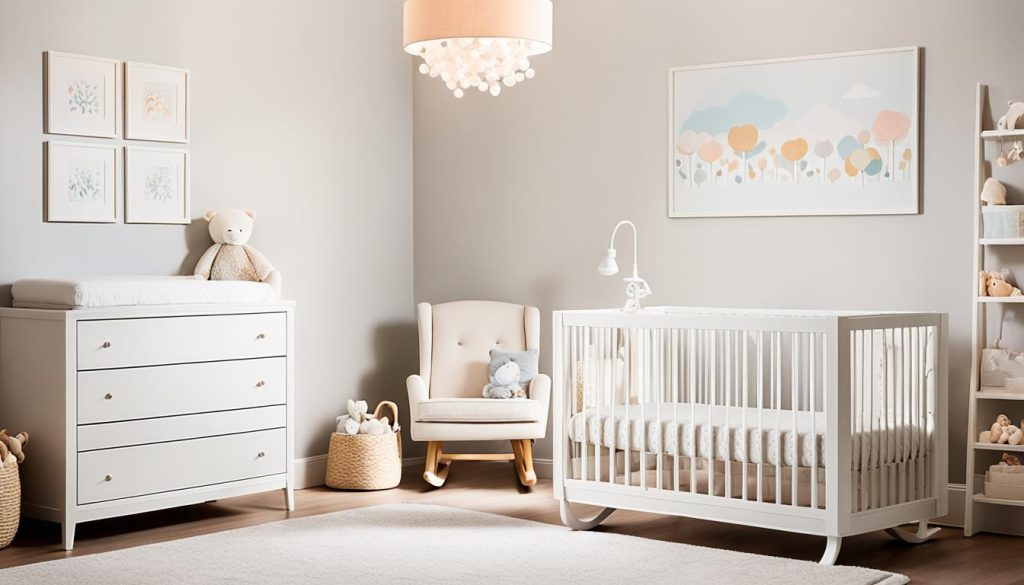
Dimmer Switches and Night Lights
Dimmer switches let you change the light for different times. Soft lighting is good for reducing stimulation. Use “soft-white” or “daylight” bulbs that are gentle on baby’s eyes.
For nighttime, turn any light into a nightlight with special bulbs. Fun nightlights can also decorate your nursery.
Natural Light Management
Control natural light to help your baby sleep well. Heavy curtains or blackout shades can make it feel like night during naps. This helps babies sleep longer and stay cool.
Always make sure window treatments are safe for your baby.
These lighting tips make your nursery flexible for day and night needs. A well-lit nursery is not just practical. It also makes the space cozy for you and your baby.
Ergonomic Considerations for Parents
When designing your nursery, think about ergonomic design. This makes the space work better and keeps you comfortable. A well-planned space makes late-night feedings and diaper changes easier on your body.
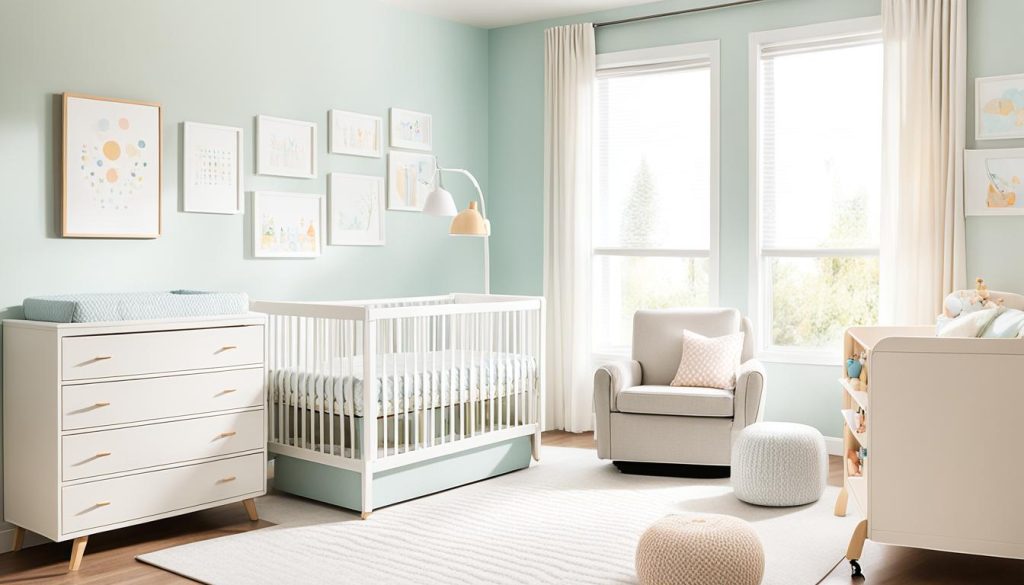
Start with a supportive rocking chair or glider. This chair will be your go-to during long feeding times. Choose one with good back support and add a footstool for better posture. Being comfortable is important when you’re in this chair for hours.
Think about the changing table height next. Make sure it’s at a height that stops back strain during diaper changes. Try to find a height that lets you stand comfortably without bending. Keep items you use often close to avoid stretching and bending.
“Prioritize comfort for yourself when selecting nursery furniture, such as a comfortable glider or rocking chair for late-night feedings.”
Don’t overlook floor space. Make sure there’s enough room to move around comfortably, especially at night. This is key for a functional nursery and your health.
- Choose furniture that adapts to your child’s growth
- Invest in high-quality, durable pieces
- Opt for furniture with ample storage options
- Consider eco-friendly materials and non-toxic finishes
By focusing on ergonomic design, you’re making a space that works for you and your baby. This thoughtful approach to nursery design makes parenting more comfortable and fun.
Creating a Cozy Reading Nook
A nursery reading corner is a magical spot where stories come to life. It’s a key part of your cozy nursery design. Here’s how to make the perfect reading nook for you and your little one.
Comfortable Seating Options
Choose seating that invites cuddling and comfort. An armchair, rocking chair, or window seat works great. For smaller spaces, consider floor cushions or poufs. The aim is a cozy spot for snuggling up with your child and a good book.

Book Storage Ideas
Keep books accessible and organized. Floating shelves display covers beautifully, enticing little readers. Baskets or bins offer easy clean-up for board books. For a unique touch, repurpose fruit crates as rustic shelving. Aim for storage that’s both functional and part of your cozy nursery design.
Soft Lighting for Bedtime Stories
Lighting sets the mood for storytimes. A soft, adjustable floor lamp works well. Wall-mounted sconces save space and add charm. If possible, position your nursery reading corner near a window for natural light. The right lighting makes reading easier and creates a soothing atmosphere for bedtime stories.
Add cozy extras to your reading nook. Include plush toys, artwork, or a canopy for a whimsical touch. Keep it tidy and inviting to encourage daily use. With these elements, you’ll create a special space where your child’s love for reading can grow.
Incorporating Growth-Friendly Furniture
For new parents, making a nursery that grows with your child is a smart move. Convertible nursery furniture is a great choice. It changes as your child does, saving you money and space.

Opt for a dresser that turns into a changing table and storage later. These versatile pieces fit well in small spaces, like a 8’9″ x 7’4″ nursery. Look for ones with removable changing pads for easy transition as your child grows.
Bookshelves are key in a nursery that grows. Start with baby items and switch to toys and school supplies later. Choose neutral colors and styles that work well in any room.
“95% of the time, a daybed in a nursery can serve as a couch, making it a versatile piece of furniture.”
Think about these options for a growing nursery:
- Convertible cribs
- Multi-function dressers
- Expandable bookshelves
- Daybeds for seating and sleeping
Choosing convertible nursery furniture means your space will change with your child. It saves money and cuts down on the need for frequent updates. Your nursery will smoothly transition from babyhood to the early school years.
Personalizing Your Nursery Design
Creating a unique nursery for your baby is an exciting part of preparing for parenthood. Personalized nursery ideas can make the room special. It reflects your family’s personality and style.
Wall Decor and Artwork
Nursery wall decor is key to setting the room’s mood. Think about an accent wall with removable wallpaper for visual interest. Hang framed artwork or prints that fit your theme.
A gallery wall with art, photos, and decor can be a focal point. This mix adds depth and beauty to the room.
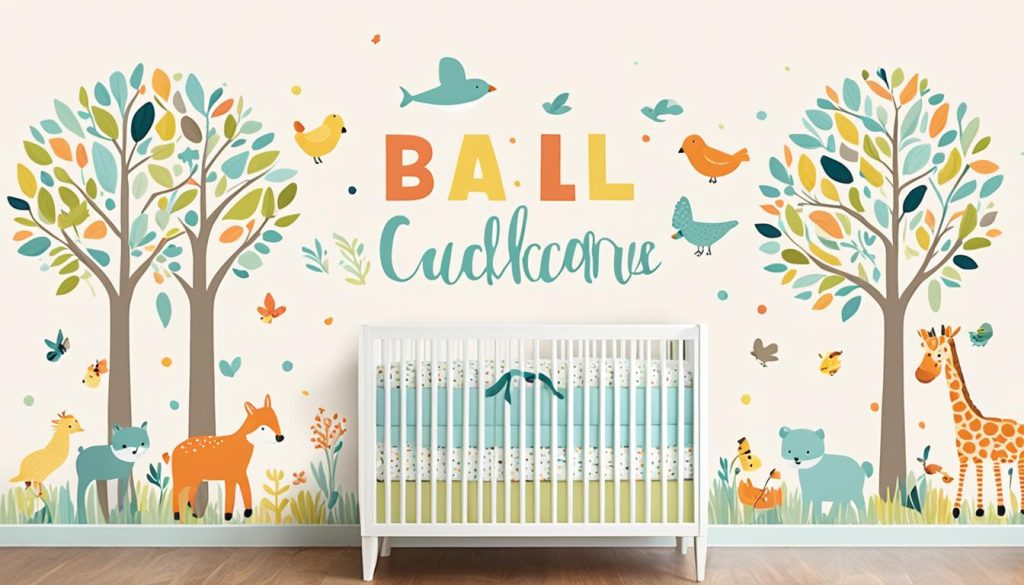
Custom Name Signs
A custom name sign above the crib or on a wall is a great idea. These signs add a unique touch and help your baby feel special. Choose from wood, acrylic, or neon lights to match your nursery’s style.
Family Photos and Mementos
Adding family photos and mementos makes the nursery warm and personal. Use stylish frames or create a photo collage. Include items like the first ultrasound picture or a family heirloom for added meaning.
Personalizing your nursery doesn’t have to be costly. DIY projects like hand-painted art or repurposed decor can be unique and affordable. The goal is to make a space that feels special to you and your family.
Organizing Baby Essentials
Smart nursery organization tips can make your life easier as a new parent. Let’s explore some practical baby room storage ideas to keep everything in its place.

Begin by using drawer dividers for small clothing items. This simple trick helps sort socks, onesies, and bibs. For easy diaper changes, set up a caddy with all the essentials. Place it near your changing area for quick access.
Maximize vertical space with closet organizers. They’re perfect for storing clothes, blankets, and extra supplies. Create a special spot for frequently used items like burp cloths. Clear storage containers make it easy to find what you need at a glance.
- Use clothespins to hang baby pants on regular hangers
- Try baby clothes dividers to organize by size
- Invest in soft storage bins for safe toy storage
Consider a rotation system for clothing sizes. Keep current items accessible and store others away. For multi-level homes, set up diaper changing stations on each floor. This saves time and effort during those busy days.
“It took two hours to declutter and reorganize the nursery, but it was worth every minute!”
Remember, good organization isn’t just about tidiness. It’s about creating a safe environment for your baby. Secure furniture to walls and use cord safety measures to prevent accidents. With these nursery organization tips, you’ll have a well-arranged, functional space for your little one.
Closing Thoughts
Creating the perfect nursery is a journey filled with joy and careful planning. As you dive into baby room planning, remember that balancing functionality, safety, and style is key. Our nursery design tips aim to guide you through this exciting process, helping you craft a space that’s both practical and delightful.
From choosing the right furniture to optimizing layout, we’ve covered essential aspects of nursery setup. Remember, the average parent adjusts about 5 furniture items for safety concerns. It’s crucial to keep cribs over 2 feet away from curtains and consider factors like air vent placement to ensure your little one’s comfort.
Don’t forget to plan for the future! Many parents list 8 planned improvements for their nurseries. Whether it’s adding crown molding, creating a magnet wall, or expanding your photo display, these personal touches make the room uniquely yours. With thoughtful arrangement and a sprinkle of creativity, you’ll create a nurturing space that grows with your child, fostering countless precious moments.


